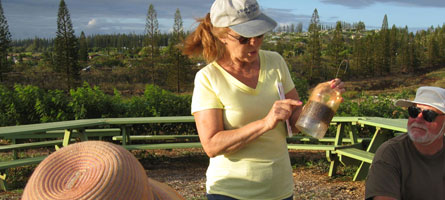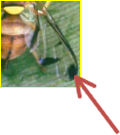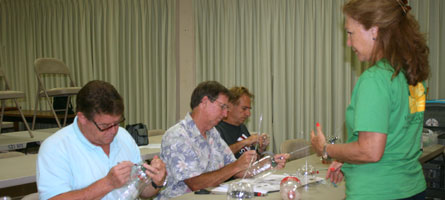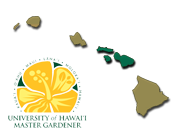
A Maui Master Gardener describes how a fruit fly trap works at Napili Community Garden.
Fruit Fly Management
Fruit Flies
Fruit flies are serious pests in Hawaii, feeding on hundreds of host plant species. They can occur from sea level to above 7000 feet elevation. There are four species of fruit fly found in Hawaii; the melon fly, the oriental fruit fly, the Mediterranean fruit fly, and the solanaceous fruit fly. The melon fly and the Oriental fruit fly are the most commonly found fruit flies on Maui.
Plant Injury
The adults of fruit fly lay their eggs in the flesh of fruits and vegetables. Once the eggs hatch, the larvae (maggots) feed on the inside of the fruit, causing breakdown of tissues and internal rotting of the fruit.
Fruit Fly Lifecycle
Female flies lay eggs into fruits and vegetables. They can lay several hundred eggs over the course of their lifetime. The eggs will hatch in 1-2 days and the larvae tunnel through the fruit over the course of 5-15 days.
Once the larvae complete their feeding and tunneling, they burrow into the soil to pupate. This stage takes approximately 8-11 days to complete and the flies emerge. The flies become sexually mature within 1-5 weeks. Once they have mated, females sting produce to deposit their eggs and the cycle begins again.
Oriental Fruit Fly
 The oriental fruit fly has clear wings and can be found at most elevations, sea level to 4000 feet.
The oriental fruit fly has clear wings and can be found at most elevations, sea level to 4000 feet.
Major hosts for oriental fruit fly include most fruits, breadfruit, carambola (star fruit), cherimoya, citrus, guava, mango, peach, and papaya.
Other hosts may include apricot, banana, grapefruit, mountain apple, nectarine, passion fruit, and many others.
Melon Fly

The melon fly is common at sea level to 1500-feet elevations and is to identify by a black spot at the wing tips and a black streak on the wing.
Major hosts include bittermelon, cucumber, eggplant, melon, pepper, pumpkin, squash, tomato and zucchini.
Other hosts may include gourds, guava, ivy gourd, papaya, strawberry guava, spiny cucumber, wild bittermelon and banana.
Management of Fruit Flies (Easy as 1, 2, 3)
Management of fruit flies includes field sanitation, protein bait, and trapping. Sanitation consists of disposing the infested fruit so fruit fly eggs and larvae don’t survive. One piece of fruit may contain hundreds of fruit fly larvae and/or eggs.
1. Sanitation
- Compost. Must be covered in plastic and maintain an internal heat of at least 140°F.
- Bagging. Bag infested fruit tightly in thick plastic bags. May be used as compost after one month.
- Animal Feed. Feed the infested fruit to your animals! Be sure that uneaten fruit does not stay on the ground for over a day.
- Burying. Buried culls must be at least 18 inches deep.
- Drowning. Submerge fruit for at least 48 hours. Once out of the water, be careful of re-infestation.
- Grinding. Use a thorough mechanical processor to grind up infested fruit. A garbage disposal will do.
2. Protein Bait
Fruit flies need sugar for energy and food high in protein to mature and reproduce. Protein baits (for example GF-120) attract and poison feeding male and female fruit flies and are a very important tactic in the fruit fly control.
GF-120 is an OMRI-listed certified organic protein bait and is available at the free monthly fruit fly classes offered by the Maui Master Gardeners at the CTAHR extension office.
3. Trapping and Monitoring
Fruit fly traps using male lures reduce the number of flies in your farm area. They also allow you to monitor your fruit fly population and the effectiveness of your protein bait. Keys to successful trapping are:
- Correct lure
- Good trap placement
- Timely trap maintenance
Lures and information about their correct placement and maintenance are available at the free monthly fruit fly-classes offered by the Maui Master Gardeners.
For more information, see Managing Fruit Flies on Farms in Hawaii and Fruit Fly Trap Assembly.

Workshop participants learn how to assemble fruit fly traps.


